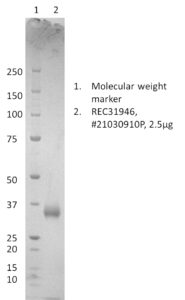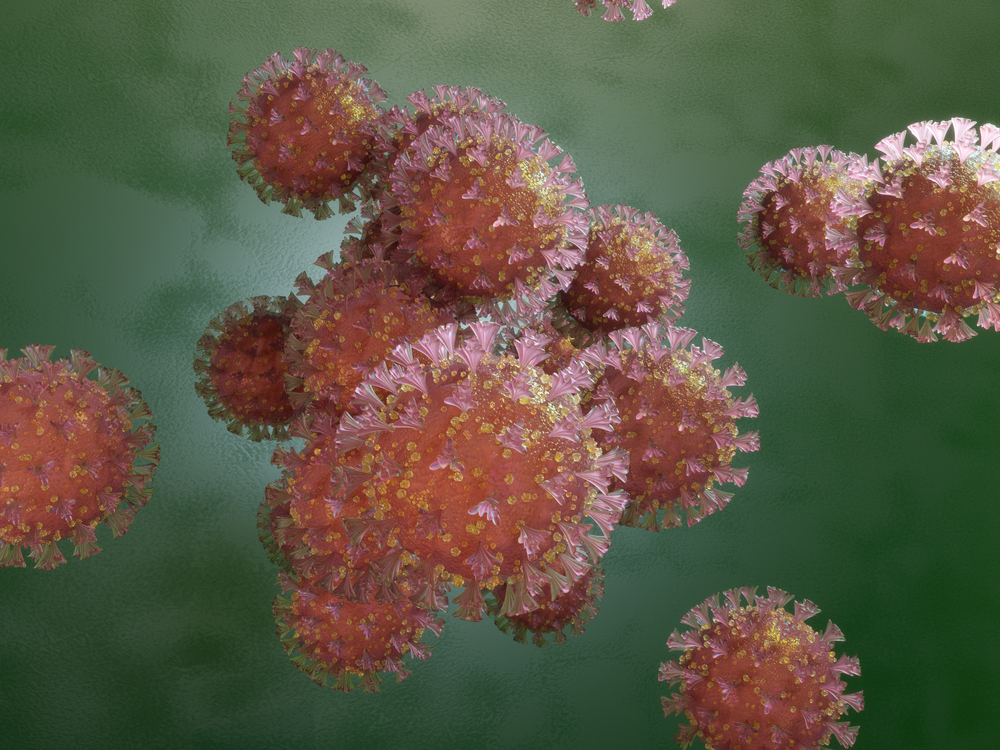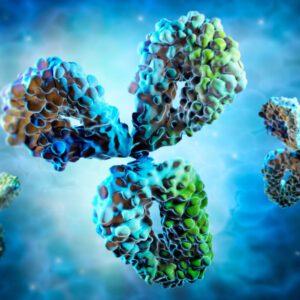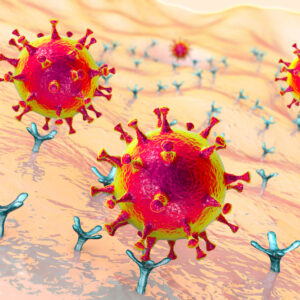
SDS-PAGE: Coomassie-stained SDS-PAGE showing purified SARS-CoV-2 (N501Y Mutant) spike RBD.
SARS-CoV-2 (N501Y Mutant) Spike Glycoprotein (S1) RBD, His-Tag (HEK293)
$652.44 – $2,486.76 excl. VAT
UNITED KINGDOM (ALPHA) VARIANT
SARS-CoV-2 (N501Y mutant) spike subunit 1 (S1) receptor binding domain (RBD) is a recombinant antigen manufactured in HEK293 cells to high purity. This antigen contains N501Y amino acid change relative to the Wuhan-Hu-1 isolate. The N501Y mutation has been reported to increase binding affinity to human ACE2. SARS-CoV-2, previously known as the 2019 Novel Coronavirus (2019-nCoV), causes the pandemic COVID-19 disease.
SARS-COV-2 (N501Y MUTANT) SPIKE GLYCOPROTEIN (S1) RBD, HIS-TAG (HEK293)
SARS-CoV-2 (N501Y mutant) spike glycoprotein (S1) RBD is a recombinant antigen manufactured in HEK293 cells to high purity. This antigen contains N501Y amino acid change relative to the Wuhan-Hu-1 isolate. The N501Y mutation has been reported to increase binding affinity to human ACE2. SARS-CoV-2, previously known as the 2019 Novel Coronavirus (2019-nCoV), causes the pandemic COVID-19 disease.
PRODUCT DETAILS – SARS-COV-2 (N501Y MUTANT) SPIKE GLYCOPROTEIN (S1) RBD, HIS-TAG (HEK293)
- SARS-CoV-2 (N501Y Mutant) spike subunit (S1) RBD, AA1-223, Acc. No. 6XDG_E (N501Y)
- Expressed in HEK293 and purified by affinity chromatography, with C-terminal His-tag.
- Presented in DPBS at
BACKGROUND
Coronaviruses have a large genome and encode a 3′-to-5′-exoribonuclease that permits high-fidelity replication and a range of tolerated variation by the viral RNA-dependent RNA polymerase (Denison et al., 2011). The coronavirus exonuclease extends the coronavirus genome size through preventing lethal mutagenesis imposed by error rates of viral RNA polymerase (Smith et al., 2014). Therefore, SARS-CoV-2 could acquire rare but favorable mutations with fitness advantages and immunological resistance due to natural selection (Grubaugh et al., 2020) and a number of mutations to the SARS-CoV-2 genome have been observed throughout the COVID-19 pandemic (Erol, 2021).
Rapidly spreading variants of SARS-CoV-2 have arisen in the United Kingdom and South Africa and these share the spike N501Y substitution, which is of particular concern because it is located in the receptor-binding domain (RBD) and increases binding to the receptor ACE2 (angiotensin converting enzyme 2). The N501Y mutation is one the key six contact residues within the RBD (Starr et al., 2020). The novel UK variant, known as VUI-202012/01 or lineage B.1.1.7 carries 14 defining mutations in the spike protein (Rambaut et al., 2020); N501Y co-occurs with several mutations of potential biological importance, including P681H and deletion of the amino acid at the 69th and 70th residues (Δ69/Δ70) on the spike protein (Leung et al., 2021). Indeed, an unusually large number of genetic changes, defines this variant with at least 24 mutations including 14 non-synonymous mutations, four deletions and six synonymous mutations in ORF1ab, ORF8, nucleocapsid and spike proteins (Leung et al., 2021).
Preliminary epidemiologic, modelling, phylogenetic and clinical findings have suggested that SARS-CoV-2 VOC 202012/01 has increased transmissibility. However, preliminary analyses also indicated that there was no change in disease severity (as measured by length of hospitalization and 28-day case fatality), or occurrence of reinfection between variant cases compared to other SARS-CoV-2 viruses circulating in the UK (WHO, 2020).
REFERENCES
- Denison M.R., Graham R.L., Donaldson E.F., Eckerle L.D., Baric R.S. Coronaviruses. RNA Biol. 2011;8:270–279.
- Erol A. Are the emerging SARS-COV-2 mutations friend or foe? Immunol Lett. 2021 Feb;230:63-64.
Grubaugh N.D., Hanage W.P., Rasmussen A.L. Making sense of mutation: what D614G means for the COVID-19 pandemic remains unclear. Cell. 2020;182:794–795. 014;1:111–132. - Leung K, Shum MH, Leung GM, Lam TT, Wu JT. Early transmissibility assessment of the N501Y mutant strains of SARS-CoV-2 in the United Kingdom, October to November 2020. Euro Surveill. 2021 Jan;26(1):2002106.
- Rambaut A., Loman N., Pybus O., Barclay W., Barrett J., Carabelli A. 2020. Preliminary Genomic Characterisation of an Emergent SARS-CoV-2 Lineage in the UK Defined by a Novel Set of Spike Mutations.
- Smith E.C., Sexton N.R., Denison M.R. Thinking outside the triangle: replication fidelity of the largest RNA viruses. Annu. Rev. Virol.
- Starr T.N., Greaney A.J., Hilton S.K., Ellis D., Crawford K.H.D., Dingens A.S. Deep mutational scanning of SARS-CoV-2 receptor binding domain reveals constraints on folding and ACE2 binding. Cell. 2020;182:1295–1310.
- WHO. SARS-CoV-2 Variants, Disease Outbreak News. 31 December 2020.



